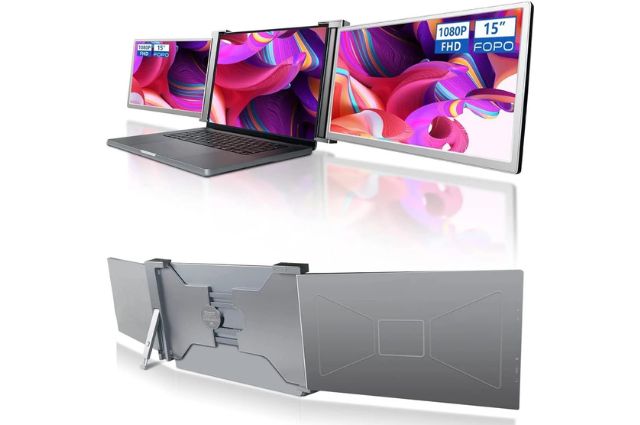
Source: Riitek
In today’s digital age, productivity and efficiency are paramount. Whether you’re a student, professional, or creative artist, having the right tools can significantly enhance your workflow. One such tool that’s gaining popularity is the laptop screen extender. This device offers a practical solution for those who need more screen real estate without the hassle of carrying around a bulky desktop setup. In this guide, we’ll dive deep into what a laptop screen extender is, how to set it up, the various types available, and the benefits it offers.
What is a Laptop Screen Extender?
A laptop screen extender is an additional monitor that can be attached to your laptop, effectively extending your display area. Unlike traditional monitors, these extenders are typically designed to be portable and lightweight, making them easy to carry along with your laptop. They can be connected via USB, HDMI, or other ports, and are powered either through the laptop itself or with a separate power source.
How to Set Up a Laptop Screen Extender
Setting up a laptop screen extender is generally straightforward. Here are the steps you typically need to follow:
- Check Compatibility: Ensure your laptop has the necessary ports (USB, HDMI, DisplayPort) that match the extender.
- Connect the Extender: Plug the extender into the appropriate port on your laptop.
- Power On: If the extender requires external power, plug it in and turn it on.
- Configure Settings: Go to your laptop’s display settings. On Windows, right-click on the desktop and select ‘Display settings’. On macOS, go to ‘System Preferences’ > ‘Displays’.
- Arrange Displays: Arrange the extended screen relative to your laptop screen by dragging the screen icons. You can choose to mirror the display or extend it.
- Adjust Resolution: Make sure the resolution of the extender matches your laptop for a seamless experience.
What Types of Laptop Screen Extenders Are Out There?
There are several types of laptop screen extenders, catering to different needs and preferences:
- USB-Powered Extenders: These are compact and draw power directly from your laptop’s USB port. They are highly portable but may be limited in screen size and resolution.
- HDMI/DisplayPort Extenders: These extenders offer better performance and higher resolutions. They require an HDMI or DisplayPort connection and may need an external power source.
- Portable Monitors: These are standalone screens that can be connected via USB-C, HDMI, or wireless connections. They often come with built-in stands and protective cases.
- Clip-On Extenders: These extenders attach directly to the laptop’s screen, providing a secondary display without taking up desk space. They are ideal for mobile work environments.
- Wireless Extenders: These use Wi-Fi or Bluetooth to connect to your laptop. They offer the ultimate flexibility but may experience latency issues depending on the network strength.
Benefits of a Laptop Screen Extender
Using a laptop screen extender comes with numerous benefits:
- Increased Productivity: With more screen space, you can have multiple applications open simultaneously, reducing the need to switch between tabs constantly.
- Enhanced Multitasking: Easily manage multiple tasks, such as coding on one screen while referencing documentation on another, or conducting video calls while taking notes.
- Better Organization: Keep your workspace clutter-free by spreading your work across multiple screens.
- Improved Focus: Reduce distractions by dedicating one screen to your main tasks and another to secondary activities like emails or social media.
- Portable Workstation: Create a dual-screen setup anywhere you go, ideal for digital nomads and frequent travelers.
Who Can Benefit from a Laptop Screen Extender?
Laptop screen extenders are versatile tools that can benefit a wide range of users:
- Professionals: Business executives, marketers, and consultants can benefit from having additional screen space for presentations, data analysis, and project management tools.
- Students: Enhances study sessions by allowing students to keep research materials and assignments open side by side.
- Creatives: Graphic designers, video editors, and digital artists can have their editing tools on one screen and the project canvas on another.
- Gamers: Provides an immersive gaming experience with additional space for game maps, controls, and communication apps.
- Remote Workers: Facilitates a more efficient remote working setup by mimicking the multi-monitor setups often found in traditional offices.
Conclusion
Laptop screen extenders are transforming the way we work, study, and create by providing the much-needed extra screen space in a compact and portable form. Whether you’re a professional looking to boost productivity, a student aiming for better study efficiency, or a creative seeking more room for your projects, a laptop screen extender can be a game-changer. Explore the various types and find the one that best suits your needs to elevate your laptop experience to the next level.







